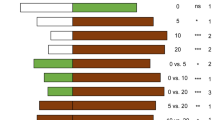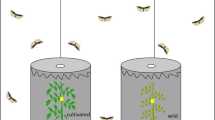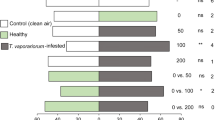Abstract
Secondary metabolites produced in glandular trichomes of tomato are involved in interactions with herbivores. In cultivated tomato (Solanum lycopersicum) glandular trichomes accumulate a blend of abundant monoterpenes and smaller amounts of a few sesquiterpenes. These mono- and sesquiterpenes are synthesized by three terpene synthases, TPS20 as well as TPS9 and TPS12, respectively. To study effects of these terpenes on performance and choice behavior of potato aphid (Macrosiphum euphorbiae), we utilized two tomato trichome mutants, hairless and odorless-2, that are differently affected in mono- and sesquiterpene production. Non-choice assays demonstrated that longevity and fecundity of M. euphorbiae were increased when kept on the trichome mutants. A principal component analysis of these aphid performance parameters and terpene production in the trichome mutants indicated that longevity and fecundity of M. euphorbiae were negatively correlated with production of the TPS12-derived sesquiterpenes β-caryophyllene and α-humulene. While we had previously shown that addition of pure β-caryophyllene/α-humulene to an artificial feeding diet affected M. euphorbiae apterae survivorship and feeding behavior, no such effects were observed here upon addition of a mixture of pure TPS20-derived monoterpenes. In olfactometer assays M. euphorbiae alates displayed differential choice behaviors towards the hairless and odorless-2 mutants suggesting a role of TPS20-derived monoterpenes in aphid attraction, which was further confirmed using a mixture of pure monoterpenes. Our analyses revealed contrasting roles of glandular trichome-derived terpenes in S. lycopersicum. While TPS12-derived sesquiterpenes contribute to host plant resistance against M. euphorbiae, TPS20-derived monoterpenes appear to be exploited as cue for host plant orientation by aphids.



Similar content being viewed by others
References
Bass C, Puinean AM, Zimmer CT, Denholm I, Field LM, Foster SP, Gutbrod O, Nauen R, Slater R, Williamson MS (2014) The evolution of insecticide resistance in the peach potato aphid, Myzus persicae. Insect Biochem Mol Biol 51:41–51
Bergau N, Bennewitz S, Syrowatka F, Hause G, Tissier A (2015) The development of type VI glandular trichomes in the cultivated tomato Solanum lycopersicum and a related wild species S. habrochaites. BMC Plant Biol 15:289
Blackman RL, Eastop VF (2000) Aphids on the world's crops: an identification and information guide, 2nd edn. Wiley, Chichester
Bleeker PM, Spyropoulou EA, Diergaarde PJ, Volpin H, De Both MT, Zerbe P, Bohlmann J, Falara V, Matsuba Y, Pichersky E, Haring MA, Schuurink RC (2011a) RNA-seq discovery, functional characterization, and comparison of sesquiterpene synthases from Solanum lycopersicum and Solanum habrochaites trichomes. Plant Mol Biol 77:323–336
Bleeker PM, Diergaarde PJ, Ament K, Schütz S, Johne B, Dijkink J, Hiemstra H, de Gelder R, de Both MT, Sabelis MW, Haring MA, Schuurink RC (2011b) Tomato-produced 7-epizingiberene and R-curcumene act as repellents to whiteflies. Phytochemistry 72:68–73
Cheng AX, Xiang CY, Li JX, Yang CQ, Hu WL, Wang LJ, Lou YG, Chen XY (2007) The rice (E)-β-caryophyllene synthase (OsTPS3) accounts for the major inducible volatile sesquiterpenes. Phytochemistry 68:1632–1641
Colby SM, Crock J, Dowdle-Rizzo B, Lemaux PG, Croteau R (1998) Germacrene C synthase from Lycopersicon esculentum cv. VFNT cherry tomato: cDNA isolation, characterization, and bacterial expression of the multiple product sesquiterpene cyclase. Proc Natl Acad Sci U S A 95:2216–2221
Degenhardt J, Köllner TG, Gershenzon J (2009) Monoterpene and sesquiterpene synthases and the origin of terpene skeletal diversity in plants. Phytochemistry 70:1621–1637
Dudareva N, Andersson S, Orlova I, Gatto N, Reichelt M, Rhodes D, Boland W, Gershenzon J (2005) The nonmevalonate pathway supports both monoterpene and sesquiterpene formation in snapdragon flowers. Proc Natl Acad Sci U S A 102:933–938
Dudareva N, Klempien A, Muhlemann JK, Kaplan I (2013) Biosynthesis, function and metabolic engineering of plant volatile organic compounds. New Phytol 198:16–32
Eichele-Nelson J, DeSutter T, Wick AF, Harmon EL, Harmon JP (2018) Salinity improves performance and alters distribution of soybean aphids. Environ Entomol 47:875–880
Falara V, Akhtar TA, Nguyen TTH, Spyropoulou EA, Bleeker PM, Schauvinhold I, Matsuba Y, Bonini ME, Schilmiller AL, Last RL, Schuurink RC, Pichersky E (2011) The tomato terpene synthase gene family. Plant Physiol 157:770–789
Fray LM, Leather SR, Powell G, Slater R, McIndoe E, Lind RJ (2014) Behavioral avoidance and enhanced dispersal in neonicotinoid-resistant Myzus perisicae (Sulzer). Pest Manag Sci 70:88–96
Gershenzon J, Dudareva N (2007) The function of terpene natural products in the natural world. Nat Chem Biol 3:408–414
Gonzales-Vigil E, Hufnagel DE, Kim J, Last RL, Barry CS (2012) Evolution of TPS20-related terpene synthases influences chemical diversity in the glandular trichomes of the wild tomato relative Solanum habrochaites. Plant J 71:921–935
Gutensohn M, Nguyen TT, McMahon RD III, Kaplan I, Pichersky E, Dudareva N (2014) Metabolic engineering of monoterpene biosynthesis in tomato fruits via introduction of the non-canonical substrate neryl diphosphate. Metab Eng 24:107–116
Hubbell SP, Wiemer DF, Adejare A (1983) An antifungal terpenoid defends a neotropical tree (Hymenaea) against attack by fungus-growing ants (Atta). Oecologia 60:321–327
Kang JH, Liu G, Shi F, Jones AD, Beaudry RM, Howe GA (2010a) The tomato odorless-2 mutant is defective in trichome-based production of diverse specialized metabolites and broad-spectrum resistance to insect herbivores. Plant Physiol 154:262–272
Kang JH, Shi F, Jones AD, Marks MD, Howe GA (2010b) Distortion of trichome morphology by the hairless mutation of tomato affects leaf surface chemistry. J Exp Bot 61:1053–1064
Köllner TG, Held M, Lenk C, Hiltpold I, Turlings TCJ, Gershenzon J, Degenhardt J (2008) A maize (E)-β-caryophyllene synthase implicated in indirect defense responses against herbivores is not expressed in most American maize varieties. Plant Cell 20:482–494
Langenheim JH (1994) Higher-plant terpenoids: a phytocentric overview of their ecological roles. J Chem Ecol 20:1223–1280
Messer A, McCormick K, Sunjaya HHH, Tumbel F, Meinwald J (1990) Defensive role of tropical tree resins: antitermitic sesquiterpenes from southeast-Asian Dipterocarpaceae. J Chem Ecol 16:3333–3352
Mittler TE, Dadd RH (1963) Studies on the artificial feeding of the aphid Myzus persicae (Sulzer) – I. Relative uptake of water and sucrose solutions. J Insect Physiol 9:623–645
Rasmann S, Köllner TG, Degenhardt J, Hiltpold I, Toepfer S, Kuhlmann U, Gershenzon J, Turlings TCJ (2005) Recruitment of entomopathogenic nematodes by insect-damaged maize roots. Nature 434:732–737
Schilmiller AL, Schauvinhold I, Larson M, Xu R, Charbonneau AL, Schmidt A, Wilkerson C, Last RL, Pichersky E (2009) Monoterpenes in the glandular trichomes of tomato are synthesized from a neryl diphosphate precursor rather than geranyl diphosphate. Proc Natl Acad Sci U S A 106:10865–10870
Schilmiller AL, Miner DP, Larson M, McDowell E, Gang DR, Wilkerson C, Last RL (2010) Studies of a biochemical factory: tomato trichome deep expressed sequence tag sequencing and proteomics. Plant Physiol 153:1212–1223
Silva AX, Jander G, Samaniego H, Ramsey JS, Figueroa CC (2012) Insecticide resistance mechanisms in the green peach aphid Myzus persicae (Hemiptera: Aphididae) I: a transcriptomic survey. PLoS One 7:e36366
Tian D, Tooker J, Peiffer M, Chung SH, Felton GW (2012) Role of trichomes in defense against herbivores: comparison of herbivore response to woolly and hairless trichome mutants in tomato (Solanum lycopersicum). Planta 236:1053–1066
Tissier A, Morgan JA, Dudareva N (2017) Plant volatiles: going ‘in’ but not ‘out’ of trichome cavities. Trends Plant Sci 22:930–938
Tomescu A, Negru G (2003) An overview on fungal diseases and pests on the field tomato crops in Romania. Acta Hortic 613:259–266
Unsicker SB, Kunert G, Gershenzon J (2009) Protective perfumes: the role of vegetative volatiles in plant defense against herbivores. Curr Opin Plant Biol 12:479–485
van Emden HF, Harrington R (2007) Aphids as crop pests. CAB International, Cambridge
Visser JH, Piron PGM (1998) An open Y-track olfactometer for recording of aphid behavioural responses to plant odours. Proc Sect Exp Appl Entomol Netherlands Entomol Soc Amsterdam 9:41–46
Wang F, Park YL, Gutensohn M (2020) Glandular trichome-derived sesquiterpenes of wild tomato accessions (Solanum habrochaites) affect aphid performance and feeding behavior. Phytochemistry 180:112532. https://doi.org/10.1016/j.phytochem.2020.112532
Will T, Steckbauer K, Hardt M, van Bel AJE (2012) Aphid gel saliva: sheath structure, protein composition and secretory dependence on stylet-tip milieu. PLoS One 7:e46903
Acknowledgements
This project was supported by Agricultural and Food Research Initiative competitive grant number 2018-67014-28092 from the USDA National Institute of Food and Agriculture to Michael Gutensohn and Yong-Lak Park. This study was also partially supported by the West Virginia Agricultural and Forestry Experiment Station (Hatch Projects: WVA00730 and WVA00024). In addition, the work of Michael Gutensohn is supported by the Ray Marsh and Arthur Pingree Dye Professorship. We thank Dr. Gregg Howe (Michigan State University) for kindly providing seeds of the odorless-2 mutant.
Author information
Authors and Affiliations
Corresponding author
Supplementary Information
ESM 1
(DOCX 20 kb)
Rights and permissions
About this article
Cite this article
Wang, F., Park, YL. & Gutensohn, M. Glandular Trichome-Derived Mono- and Sesquiterpenes of Tomato Have Contrasting Roles in the Interaction with the Potato Aphid Macrosiphum euphorbiae. J Chem Ecol 47, 204–214 (2021). https://doi.org/10.1007/s10886-021-01243-4
Received:
Revised:
Accepted:
Published:
Issue Date:
DOI: https://doi.org/10.1007/s10886-021-01243-4




